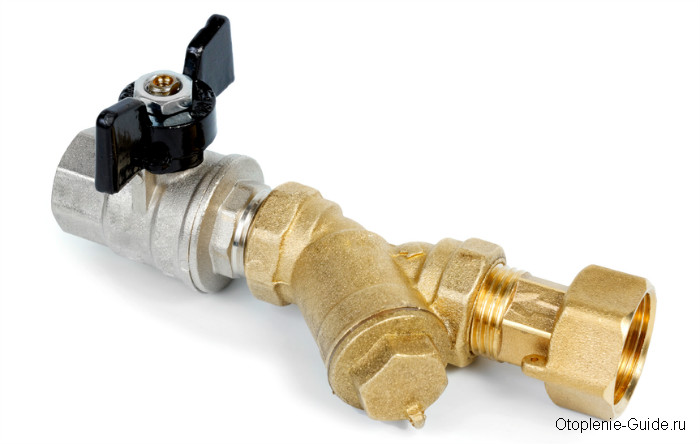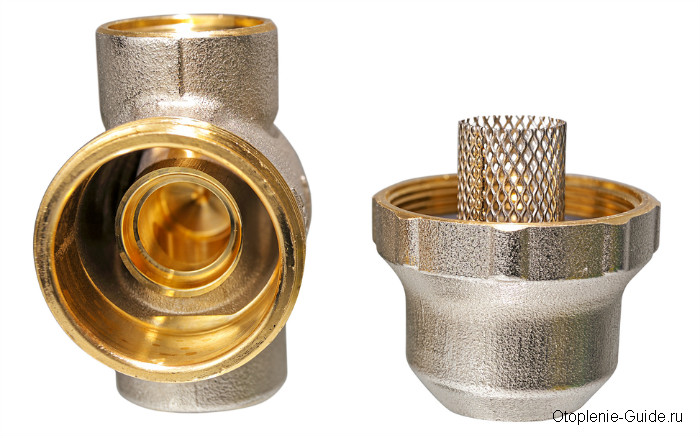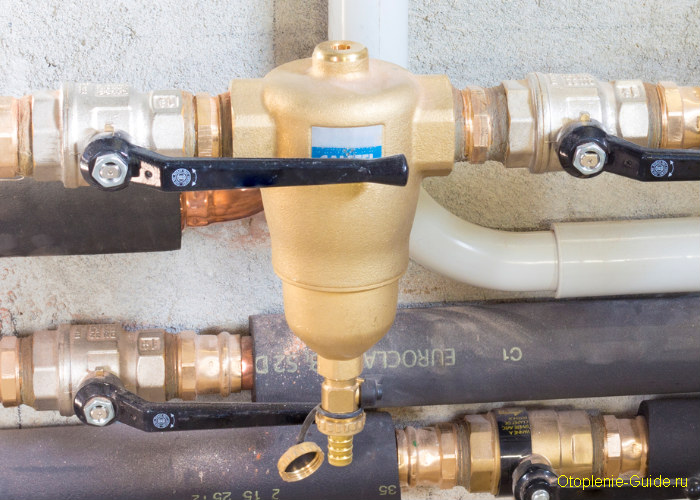Coarse mud filters. Mud for heating system: device and principle of operation, advantages of use. Cast iron "oblique" magnetic filters.
The heating system consists of many mandatory units, each of which performs its own specific functions. One of these elements is a mud filter for water, which is used to clean the coolant from foreign particles. This simple device has a significant impact on the efficiency of the heating system. This is especially noticeable in complex systems with a large number of control valves.
Finally, heating water is only a low-salt alkaline liquid with an extremely minimal oxygen concentration. The magnetic rod and various functional parts are mounted in a brass housing. This allows you to adjust the through flow in accordance with the selected working stage. This is indicated on the housing adjustment cover. With this setup, the pressure loss is slightly higher, but a very high deposition rate has already been achieved in the first cycle. The filter setting can be selected within approximately 10-15 minutes.
The volumetric flow is passed through a filter filter that holds non-magnetic particles larger than 50 μm, after which the filter filter is washed in the opposite direction and non-magnetic sludge is removed. Rotating screw connection allows you to install it in any position. Functional principle The internal design ensures that most of the sediment contained in the plant water settles and is simply washed.
What does the installation of mud collectors for the heating system give?
With the need to install mud filters for water in centralized heating systems, no questions arise. Where the coolant is periodically drained and the system is refilled, it is impossible to argue with the obligation of this element in the system - there will always be dirt and impurities.
Although the Brazilian does not have a large filter, in the figurative sense of the word the best filter in the world is the Brazilian! In addition, water usually comes out of a fresh tap, since ceramics reduce the temperature by about 5 degrees Celsius. Such clay filters or ceramics are champions in filtering water waste, removing up to 99% of the parasites that cause the disease. They also almost completely pollute chlorine, pesticides, iron, aluminum and lead.
The water in your city may even have a reputation for being well-treated, but it is best to provide a good filter with a candle so as not to risk it. This is because the water supply that takes water from the sewage treatment plant to your home may contain flaws that allow pollutants from the groundwater level to come into contact with what you drink.
The neglect of the mud collectors begins with the independent design of small autonomous systems. For example, heating systems of a private house. It only seems that in a closed loop of small size, there is nowhere to get foreign impurities in the coolant from.
Whatever type of coolant is used, and no matter what initial cleaning it is subjected to, it will still be based on water. Water, which begins to interact with the metal nodes of the system, and metal is in any system. As a result of this interaction, rust particles circulate in the system. In some parts of the system (irregularities inside the pipes, weld flows, sharp turns, narrow passages, etc.), these particles accumulate, which impedes the movement of the coolant.
Unhappy decay of clay filters
This is especially dangerous when in cities with water crises, such as Sao Paulo, the water pressure decreases, since the point of leakage of the pipe can become a gateway to the mud. Not justified. The pressure of water on activated carbon filters compromises the filtration process, and bottled water is not a guarantee of quality, as we are interested in the marketing sectors of large companies.
This article, divided into two parts, discusses various topics related to qus ponds. It is difficult to find information in Castile that is scarce and often interested, either because it is sponsored by a trademark or because it was written by fans who want to impose an idea, usually for economic reasons. Cheap, if good, excellent. But if it is not, it loses the adjective cheap for one of the very expensive. These elements will be divided into several subgroups.

Since the intensity of the coolant circulation decreases, in order to achieve the required parameters of the temperature regime in the room, it is necessary to increase its temperature. This increases the load on the boiler and all other elements of the system, which does not add to them reliability, efficiency and effectiveness. Proper installation of mud collectors in the system eliminates most of these problems, or at least pushes the time of their occurrence.
Elements inside the building. These are the ones that we must consider when building a pond, and that they will be included in the same structure. His mission is very simple, but irreplaceable. Soil will come from the bottom of the pond to the filter. We will supply a sufficient number of them, although usually two. The usual measure of output, which should be, is 110 mm.
Another dimension can also be set, although 110 is the most widely used. In addition to this configuration, an upward flow of water is generated that directs the dirt particles towards said lower runoff. In doing so, we achieve two main effects. Create a drain current that causes dirt to drain to the bottom.
Mud classification
The principle of operation is to pass the coolant through a special mesh or magnetic filter, sift the mud fractions and deposit them at the bottom of the glass. The main condition for proper operation is the installation of a sump in the direction of flow of the coolant.
Classification of sumps for heating systems is made according to several criteria. According to the degree of cleaning, fine and rough cleaning devices are distinguished. According to mounting options: threaded, flanged and welded. By the method of service:
That is, we make the installation much more efficient. This is a simple auxiliary water intake, but very useful for supporting the pump, for installing heaters, ozone reactors, or other peripheral elements. One of them supports the bomb. Pump flow may be greater than filter capacity. It also serves as a passage when we look at the pond, which can affect the bacterial colony in which the filter is located; Or, if the mechanical filter is a sieve type, so that it can stop and work on it without stopping the entire system.
- self-washing - the sediment from the sump and is washed off from the surface of the mesh by a stream of water when opening the crane on the mud sump;
- flushing - the cup is washed without removing the filter, but manually;
- non-flushing - for cleaning, it is required to dismantle and disassemble the assembly.

The main types of dirt filters and their device
Very important elements, and although we do not install them at the beginning, we must take them into account when thinking about future installations. These 4 are recommended, but if you expect more, much better, it is not expensive and can be useful for any device or extension that we will install in the future. We just leave it with a locked key. The pipe measurement for medium water can be 50 or for auxiliary equipment and pump support with 50. And for return in winter it is advisable.
The relevance of installing heating filters
From the bottom drain to the filter. In order to conduct water from the lower outlet to the filter, it is desirable that the pipe measurement be larger or smaller, although the use of this measurement is common or more practical. As for the quality of pvc, it is preferable that the pressure is steady and steady, although the usual quality of the drainage works perfectly, especially when it is buried in concrete and the pressure that it will support is the pressure in the column of water.
Filter Classification
Strainers. The most common and familiar type of sump filter for water used in everyday life. In the simplest design, dirt is trapped by the net and settles in the accumulation zone. Periodically, the bottom of the glass turns away and the dirt is removed. The design can be supplemented by a drain valve installed instead of the bottom, and then the sump from the wash becomes a self-wash.
The pipe should be delivered to the filter as straight and straight as possible, avoiding elbows. When setting the elbow to 90 °, it is best to use a large radius to have the smallest flow loss. You can also use two 45º. As for valves, they exist in the market of several classes, although the most commonly used balls or balls, as well as guillotines. Each of them has its advantages and disadvantages.
Balls or ball show as an advantage an almost perfect closure. But since the inconvenience is large in size and weight, which is quite difficult to install. Guillotines, as inconveniences, show a less perfect closure than a ball or sphere, although if we choose the quality mark, we will not have a serious problem.
The installation of an additional mesh that removes air from the coolant, the float and the needle valve adds to the mudguard the function of protection against gas contamination. The effectiveness of the mesh sump depends on the pressure in the line before and after it. With a significant difference in these values, solid particles can be forced through the grid.
Magnetic filter removes metal particles from the coolant stream. During the operation of such a filter, no inhibitory effect on the fluid flow occurs, which is important during the operation of powerful pumps.
There are also inertial-gravitational and subscriber mud collectors. The principle of operation of the former is clear from their name and they are applied at large enterprises. Subscriber devices clean the coolant at the entrance to metering stations.
Features of the use of mud
All dirt filters for heating systems can also be divided into those designed for vertical or horizontal installation. Vertical structures are more often used in large heating systems. It should also be remembered that vertically mounted sumps need to be serviced more often. The selection of sizes and cleaning parameters is based on the diameters of the pipelines, the capacity of the pumps and the installation locations.

During installation, there are several rules that must be followed.
- Arrow on the body. As a rule, the filter has an arrow indicating the direction of movement of the coolant.
- The best location is a horizontal section of the pipeline.
- Spatial orientation. The branch with a net and a nut or a drain cock should face down.
- The presence of shutoff valves before and after the sump filter for water, as well as a pressure reducer after it.
- Convenience of service.
Where in the heating system are dirt collectors installed?
- Before metering devices, if any. Counters are classified as precision instruments and are extremely sensitive to contamination.
- In front of boiler heat exchangers.
- On circulation and make-up pipelines.
- In front of dampers, sensors and other system elements as necessary.
Mud service in the heating system
Sumps are cleaned at least twice a year - before and at the end of the heating season. The frequency largely depends on the size of the system, the intensity of the coolant recharge and the degree of its preliminary cleaning.
In most cases, maintenance of household dirt filters can be done independently. It is enough to block the lines, unscrew the glass stopper, remove and wash the filter mesh.
Equipping heating systems with mud filters allows you to protect expensive system components, reduce the frequency of flushing and replacement of the coolant, and, consequently, operating costs.
